Reconnaissance about German infantry and cavalry near the border of the USSR
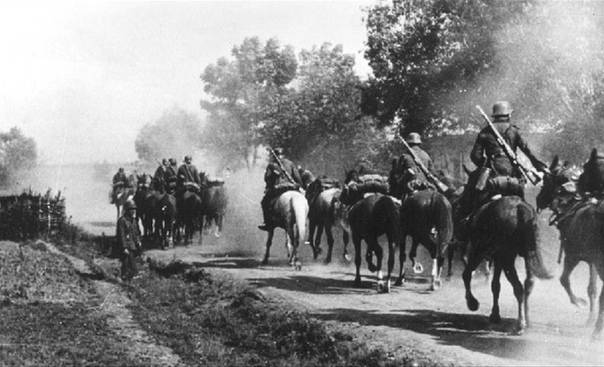
The following abbreviations are used in the article: IN - military district, GSh - General base, Spacecraft - Red Army, cd (kbr, kn) - cavalry division (brigade, regiment), md (mp) - motorized division (regiment), one - security division, pd (pp) - infantry division (regiment), Goals Difference - intelligence materials, Ro - intelligence department of VO, RU - Reconnaissance GSh KA, td (mn) - tank division (regiment).
In the previous part it was shown that our intelligence services did not have sources of information in the German large headquarters. Therefore, intelligence could collect information about the troops concentrated near the border of the USSR, only through visual observation and tracking rumors among the local population. The reliability of RMs obtained by such methods was low.
When obtaining information using visual observation, the main emphasis was on insignia and insignia that were placed on shoulder straps. According to sources, in May 1941, the German command decided to withdraw the reconnaissance mark, which was associated with the marks on the shoulder straps. The numbers were spore, but on the faded shoulder straps, traces of marks were clearly visible. There were some stupid Germans! However, after the start of the war, all their stupidity for some reason disappeared at once. Until the beginning or mid-June, our scouts did not even think that the signs could be used by the German command for misinformation.
Time of information passage before being included in the RC reports
On May 31.5.41, 1, another report of RU is published, which provides data on the distribution of the German armed forces by theaters and military fronts as of June 15. On June 1.6.41, the last pre-war report of the RU was prepared, which contains the same data as in the previous report. Additionally, the summary includes the document "Dislocation of German units and formations by groupings in the border strip with the USSR on XNUMX (according to intelligence and data from RO PribOVO, RO headquarters ZAPOVO, RO headquarters KOVO". in this article... Upon further reference, the document will be called "Dislocation of German units ..."
The data on the deployment of German troops near the border, which are given in the report of the RU of June 15, can be compared only with the map of the operational department of the General Staff of the Wehrmacht Ground Forces dated May 27.5.41, XNUMX. Therefore, it is necessary to understand what the latest date can correspond to the RM, which were included to the document "Dislocation of German units ..."
The report of May 31 was signed by the head of the RU on the same day. Consequently, RMs for this report could arrive until the evening of May 31.
RM for reports came to RU from their agent sources (including military attachés in different countries), from the RO of the border western military units, from the NKGB intelligence services and the NKVD border troops.
The fastest way to reach the Republic of Moldova could come from undercover sources that had radio communications. The author reviewed the published materials from the RU agent sources from January 1941 until the beginning of the war. These reports provide information on the total number of German divisions at the border, in the Balkans, in France (with deployment sites) and in other theaters of military operations, and on the transport of German troops. But in these messages there is no information about the places of deployment at the border of German divisions or their headquarters, regiments and smaller units. As an example, excerpts from some spy messages are given:
"Mars" (15.6.41): “The Slovak reported: In addition to the five German divisions deployed 3 weeks ago from the Presov region to Poland, from June 9 in the Presov - Vranov region [Slovakia, 34-88 km to the border. - Approx. auth.] 4 new divisions have appeared, of which 2 are motorized mechanized divisions ... ”Resolution in RU on a communication dated June 16.
"Dora" (17.6.41): “On the Soviet-German border there are about 100 infantry divisions, of which one third are motorized ... In Romania, there are especially many German troops near Galati. At present, selected special-purpose divisions are being prepared, these include the 5th and 10th divisions stationed in the General Government ... "Information on the date of admission to the RU is not given.
The minimum time for information to pass from sources through residents and radio operators in the RU is about three days: the source saw the movement of troops, the next day the information reached the resident, who, having compiled a message, transmits it to the radio operator, and on the third day of the RM, it goes to the head of the RU. Further, the spy message is addressed, sometimes a report with a map to the head of the RU and the receipt of this information to the performer for inclusion in the report. In this case, the troops or transport could see no later than May 28. It is very likely that undercover sources in East Prussia and former Poland were transferred to the communications of the RO PribOVO, ZAPOVO and KOVO.
The RO of the headquarters of the border western military units received information from their intelligence sources, from operational points, from radio intelligence, from intelligence agencies of subordinate armies, the NKGB and the NKVD border troops.
In the intelligence reports of RO VO there is a lot of information about the locations of the German troops, about the numbers of units, formations, army corps and armies. The transit time of undercover messages from the source to the RO using communication means can also be about 3 days. Further, these RMs are included in the summary of the RO of the district, which will later be sent to the RO. In this case, information on the deployment of German troops as of May 26-27 will be included in the report of the RU. When transferring information from sources using a mailbox system or messengers, the transit time of the RM may increase.
A lot of intelligence messages also passed through the operational intelligence points, a survey of border trespassers was conducted, perhaps a survey of railway employees who arrived from the adjacent territory was conducted. Since an extra link appeared in the information transmission chain, the transit time of the RM could increase.
The time of passage of the RM through the intelligence agencies of the NKGB and the border troops of the NKVD can be comparable:
- to RU - with the time of receipt of information from RO VO;
- before RO VO - with the time of receipt of information from operational points.
Therefore, we can say that a significant part of the RM, which were used in drawing up the document "Dislocation of German units ...", reflected the situation not earlier than 27.5.41.
German divisions in Romania, Hungary and Slovakia
In accordance with the report of RU from 31.5.41 or 15.6.41, the German troops were: "In Slovakia (district Zborov, Presov, Vranov [from 50 to 104 km to the Soviet border - Approx. Auth.]) - 5 mountain divisions; in the Carpathian Ukraine - 4 divisions; in Moldova and Northern Dobrudja - 17 divisions, including 10 infantry, 4 motorized, one mountain and two others ... "
Below in the picture you can see that only the 97th light front line from near Munich will be redeployed to Slovakia. There are no five German mountain divisions in Slovakia. They can only be portrayed by certain groups of military personnel dressed in the uniform of mountain shooters.
There are no four German divisions in the Carpathian Ukraine. They also do not exist throughout Hungary. And again, someone depicts these divisions, since we are talking about rechecked RM. As of June 22, the number of mythical divisions in these territories will even increase ...
Below on the map the locations of the deployment of six German infantry divisions in Romania as of 27.5.41 are presented. The remaining 11 German divisions, which are listed in the summary, are the result of misinformation by the German command ...
It can be seen that there is a gross error of our intelligence in determining the number of German divisions on the territory of Romania, Slovakia and Hungary. The presence of up to 20 mythical German divisions in these territories testifies to the scale of the disinformation measures carried out by the German command ...
German divisions in East Prussia and the former Poland
In accordance with by a summary of RU from 31.5.41 or on 15.6.41: 72-74 German infantry divisions are concentrated on the territory of East Prussia and former Poland (including the area of Danzig, Poznan, Thorn). In fact, there are 70 infantry and security divisions on this territory, two of which are redeployed from France and Germany. We can say that RM on infantry divisions are fairly accurate. The figure shows a fragment of the map of the operational department of the General Staff of the Wehrmacht ground forces (27.5.41) with the locations of the divisions in the territory of East Prussia and the former Poland.
The tables below show the numbers of infantry and security divisions, as well as infantry regiments actually located at the border (including redeployed troops), as well as divisions and regiments that are mentioned in the document "Dislocation of German units ..." Some of the numbers of divisions and regiments are not defined in the document and therefore it is not presented in the tables. Matching numbers are highlighted in red. On the right is the percentage of reconciliation data with the numbers of units and formations actually located at the border.
The coincidence is between 19 and 44%. We can say that this is a fairly good coincidence, since for other divisions and regiments, which will be considered below, the coincidence will be much lower.
What should the German command have done to hide their plans for a blitzkrieg against the Soviet Union until June 21-22?
1. To show our intelligence services near the border the presence of large infantry groupings with artillery units, which are nevertheless stationed far enough from the border. Infantry groupings are incapable of a lightning attack to great depths. Therefore, these groups will not alert the leadership of the spacecraft and the Soviet Union. Simulate the preparation of fortifications and defensive lines by the infantry forces, carry out the withdrawal of anti-tank artillery into positions. Implemented.
2. Large infantry groupings may have cavalry, separate armored units, and possibly even armored divisions for reinforcement. At the same time, the deployment of tank forces should not give rise to the thought of the presence of undetected mobile strike groups or tank groups. Implemented.
3. Conceal the redeployment to the border of the tank and motorized divisions of the motorized corps when they are concentrated near the border. Implemented.
4. Lack of large forces aviation at airfields near the border until the end of the concentration of ground forces. The absence of a large number of parachute and airborne divisions at the border. Since the German command in every possible way showed the presence in the Wehrmacht of a large number (8-10) of non-existent indicated divisions, the presence of less than two of them near the border should not have alerted the command of the spacecraft. Implemented.
Wehrmacht cavalry
The 1st cbr existed in the Wehrmacht since 1936. There were also 13 Reitar (cavalry) regiments. The successes of the 1st cd in the war with Poland led to the fact that on 25.10.39 the 1st cd was formed on its basis. In May 1940, the division includes: 1st, 2nd, 21st and 22nd regiment, 1st cavalry artillery regiment, 1st scooter battalion, 40th anti-tank battalion, 40th sapper battalion, 86th communications battalion. It should be noted that in the structure of the 1st cd It never happened cavalry brigade.
In September 1940, the division was redeployed to the territory of the General Government. It is known that since November 2, the 1st cd was in the region of Brest. The division headquarters was stationed in the city of Miedzyrzec. The division was in the area until mid-June.
In September 1939, an SS Cavalry Regiment was formed in Berlin, which arrived at the General Government at the end of the month. On 21.5.40 the regiment was reorganized into two SS cavalry regiments: 1st and 2nd. The 1st SS CP was stationed in Warsaw, and the 2nd - in Lublin. On 24.2.41, the formation of the 1st SS brigade began as part of the indicated regiments. The brigade's headquarters was in the city of Lukov. The 1st SS CP crossed the border with the USSR only at the end of June 1941. The 2nd SS CP until July was in the territory of the General Government.
Thus, by the beginning of the war, six CPs were deployed near the border on the territory of former Poland, consisting of one cavalry division and one cavalry brigade.
Before mobilization began in the summer of 1939, the infantry divisions did not have their own reconnaissance battalions. The reconnaissance battalions began to form on the basis of 13 cavalry regiments (Reitarsky), which ceased to exist. The total strength of the battalion was 623 people. It consisted of a cavalry squadron (three platoons of 42 people each), five horse-drawn guns, 50 motorcycles, 49 cars, 3 armored vehicles and 260-300 horses.
Some of the infantry regiments included a cavalry reconnaissance platoon.
Troop colors of German troops and services
The golden yellow color was the Waffenfarbe of cavalry formations and units, as well as reconnaissance units of infantry divisions. Waffenfarbe infantry units, cavalry reconnaissance platoons, infantry regiments were white. If our scouts knew about this, then they could easily distinguish cavalry units from other units and subunits. Difficulties arose in the event that our intelligence did not know about this ...
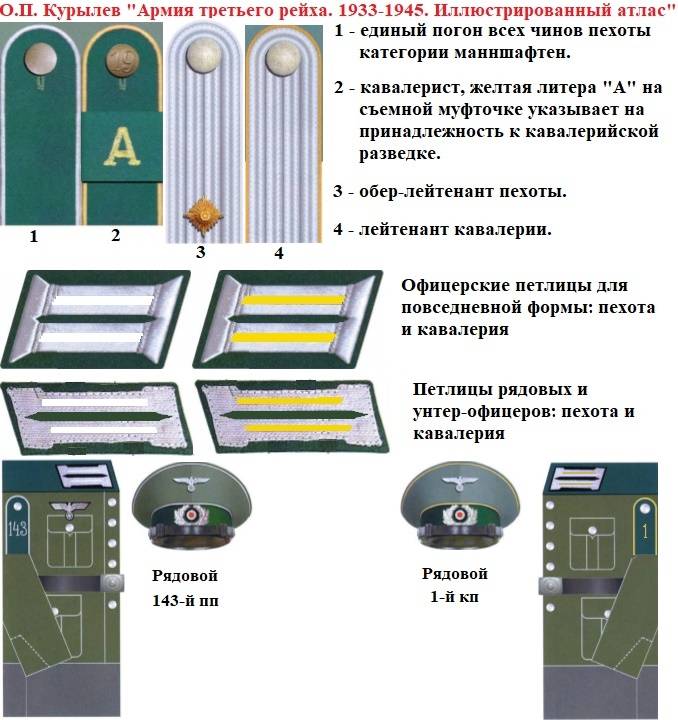
Mention of cavalry in reconnaissance materials
According to the author, one of the measures to misinform our command was the excessive increase by the German command of the number of cavalry units concentrated at the border. This misinformation found its place in the RM, which came from various departments. For example:
1.5.41 ... According to data received from various sources, Germans concentrated on the border with the USSR about 4 million troops, about 800 thousand cavalry and 4000 planes ... "
The book M. I. Meltyukhova "Stalin's Lost Chance" states that "For the attack on the Soviet Union, the German command allocated 4050 thousand people" (in the land army and the Waxes of the SS, in the Air Force and the Navy).
On 1.5.41, there were about 51 German divisions near the border, which accounted for 38% of the number of formations that will be concentrated on June 22. By May 1, there was a small amount of Luftwaffe forces at the border ... Therefore, we can say that by May 1, there were about 2 million German soldiers at the border.
A fairly large number of cavalry divisions are noted in the NKVD Certificate (not earlier than 23.5.41):
Deputy People's Commissar of Internal Affairs Lieutenant General Maslennikov.
Some reconnaissance agencies determined the German cavalry regiments by the number of horses: “[29.5.41 g.] ... The presence of cavalry in the Ostrov region up to 1,5 thousand horses can be considered in this region for the deployment of a cavalry regiment ... " It turns out that herds of horses of infantry divisions, each of which had 1743 riding horses and 3632 draft horses, could be mistaken for cavalry regiments.
The document "Dislocation of German units ..." mentions one cavalry division headquarters, four cavalry brigade headquarters and 23 cavalry regiments. The numbers of the cavalry division, three cavalry brigades and 13 cavalry regiments were known to intelligence. Subsequently, before the start of the war, intelligence learns about three more regiment numbers: 12th, 110th and 537th. Below are the numbers of the regiments according to intelligence data and the numbers of the regiments that were actually located at the border. The coincidence in the numbers is only 6%. The rest of the numbers are probably bogus ...

The determination of the numbers of the 1st and 2nd kp were counted as a reconnaissance error, since these regiments were never stationed in East Prussia. In addition, the presence of these regiments in East Prussia was confirmed by intelligence on the eve of the war, which is a clear consequence of disinformation ...
You might think that the scouts simply confused the cavalry squadrons from the reconnaissance battalions with cavalry regiments, but this is not the case ... Below on the fragments of the maps are marked the locations of the cavalry units in accordance with the RM. When considering the intelligence data, the conclusion suggests itself not entirely disingenuous ...
The table below provides information on the deployment of cavalry units in accordance with the document "Dislocation of German units ..." and intelligence data on units as of June 21. Possible redeployment sites are marked in blue.
The table shows that:
- the headquarters of the 1st cd was in Warsaw from the end of May to 21 June, which was not true. For 7,5 months, intelligence was unable to establish that this headquarters was located in the city of Miedzyrzec;
- reconnaissance found four mythical headquarters of the cavalry brigades as of May 31 and confirmed the presence of three of them in the same places as of June 21. This can also only indicate the misinformation of our command;
- Many cavalry regiments disappeared from the places of deployment, where they were by May 31, but many regiments appeared in new places. The appearance of new cavalry regiments at the border, which could not be there, does not indicate a good work of intelligence.
By June 21, according to the RO of the headquarters of the Western Military District, the number of cavalry formations in the district zone reached a significant value - up to 5,7 divisions:
2. Mlavskoe direction ... kp - three.
3. Warsaw direction ... one cd;
4. Demblin direction ... up to three cd ...
We can draw the following conclusion: at the end of May, the presence of infantry divisions at the border of the German command did not particularly hide. The intelligence data turned out to be close to reality. However, the true numbers of most of these divisions were hidden or distorted.
The number of cavalry formations and units was deliberately overstated by the German command. Many of them turned out to be fictitious. This is evidenced by the exact knowledge of their numbers by our intelligence, although the overwhelming majority of these formations and units never existed.
To be continued ...
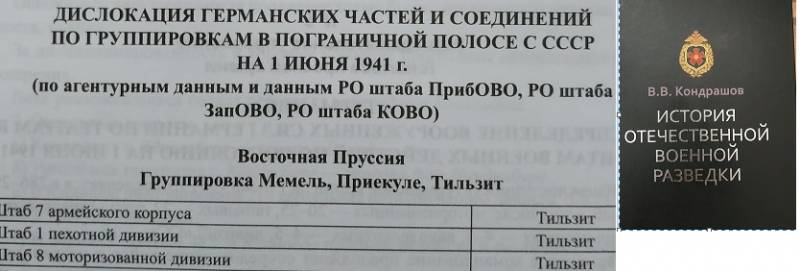
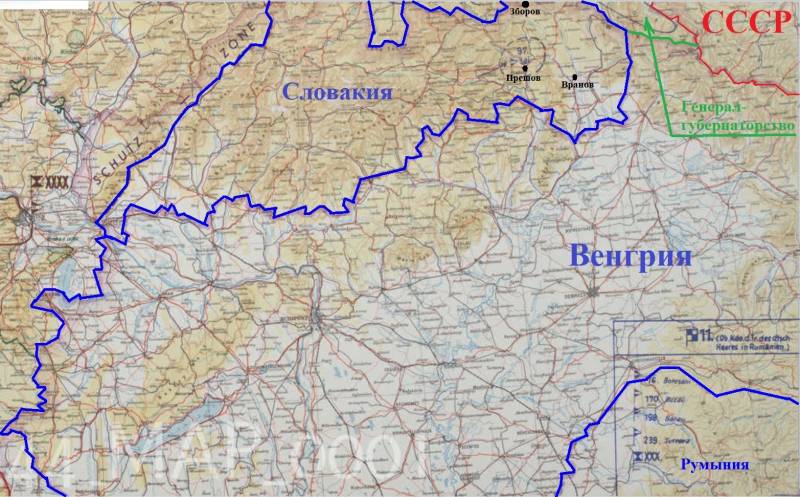
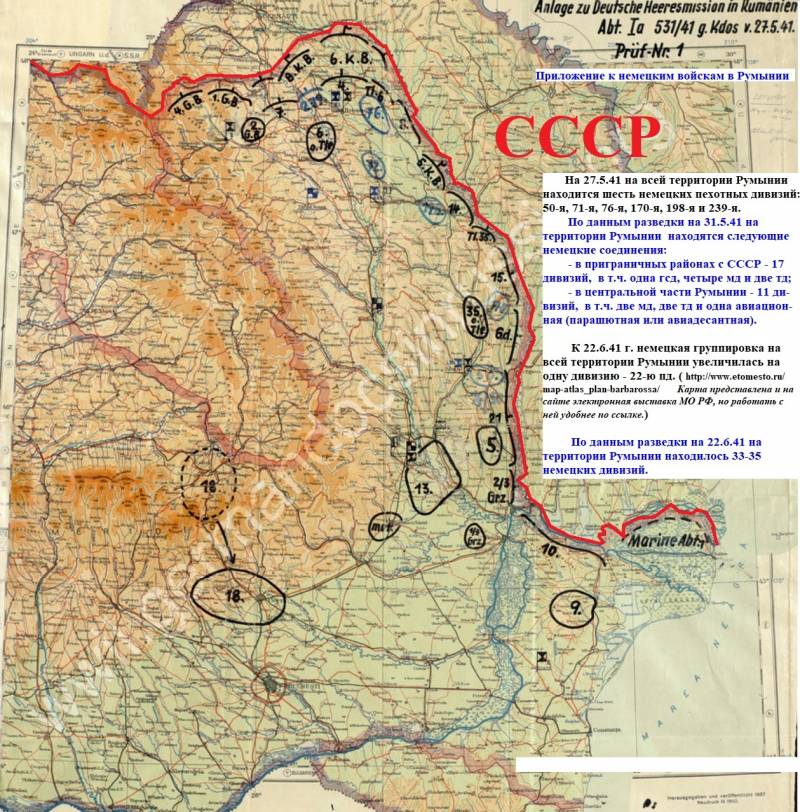
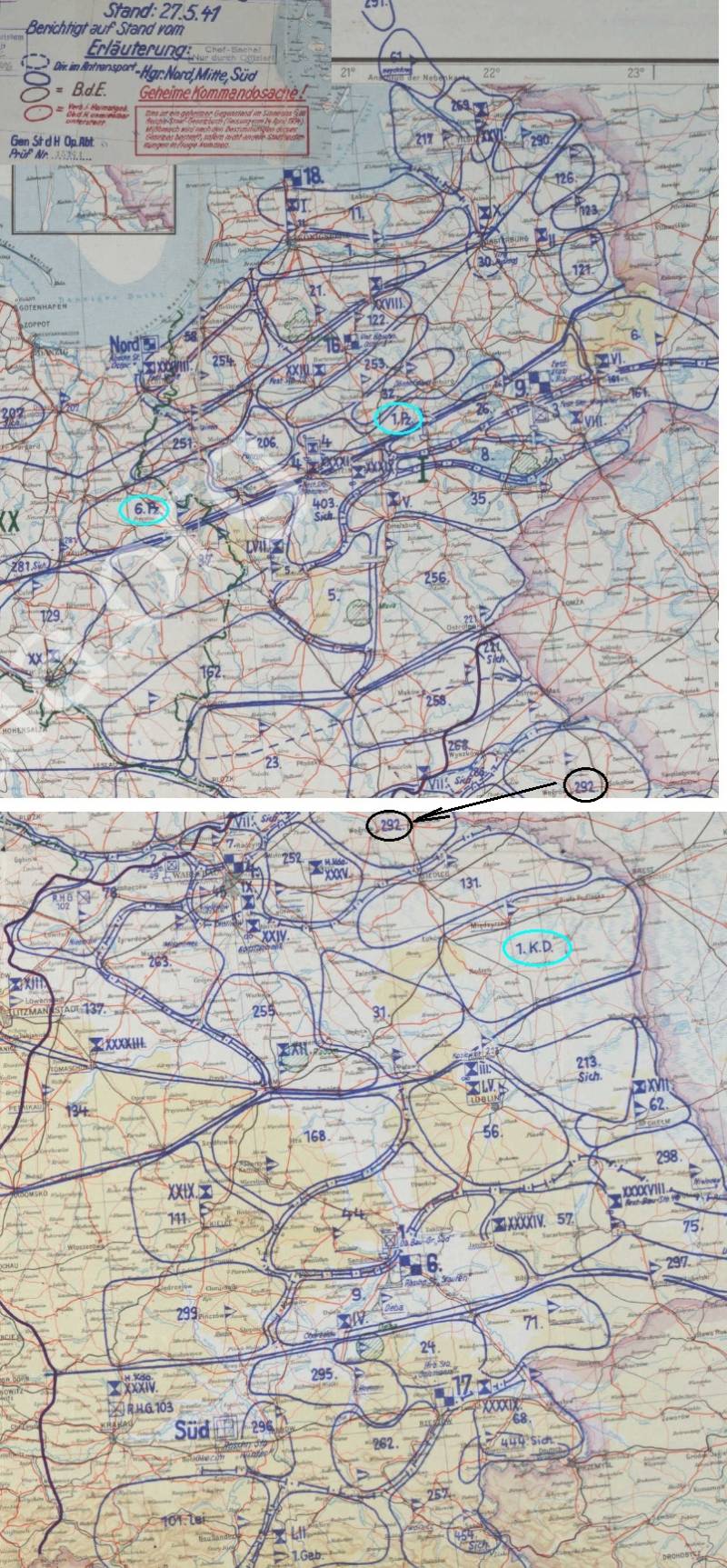
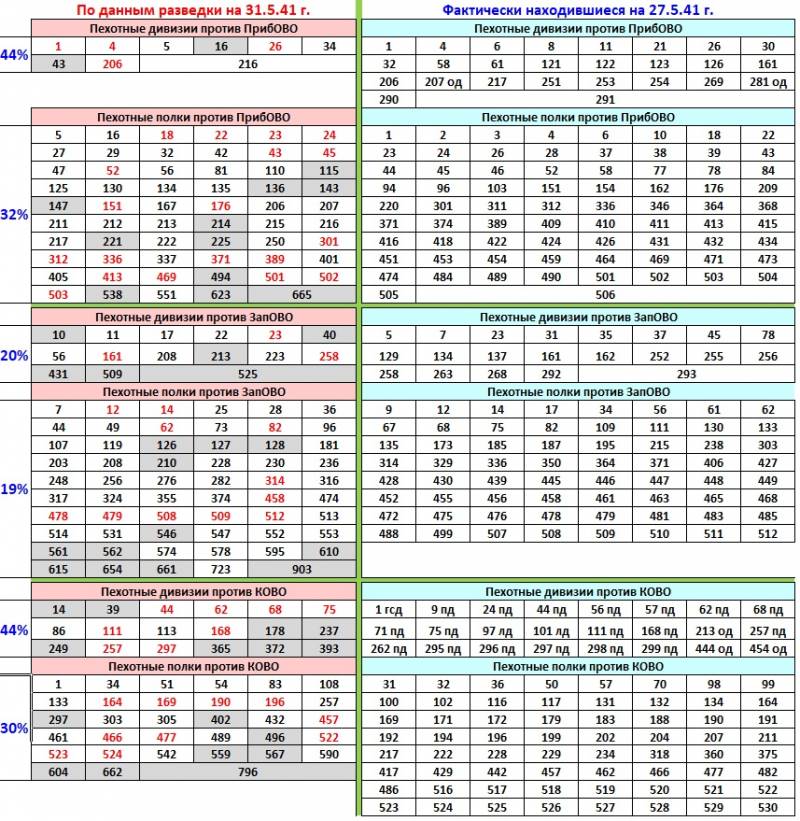
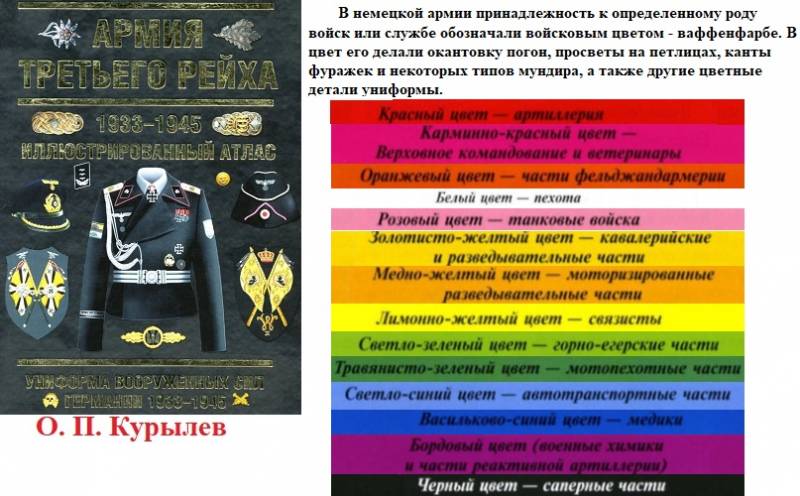
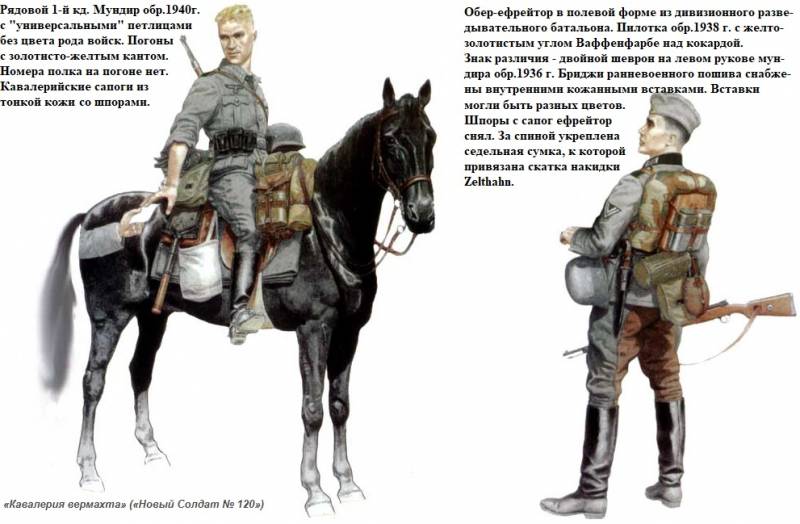
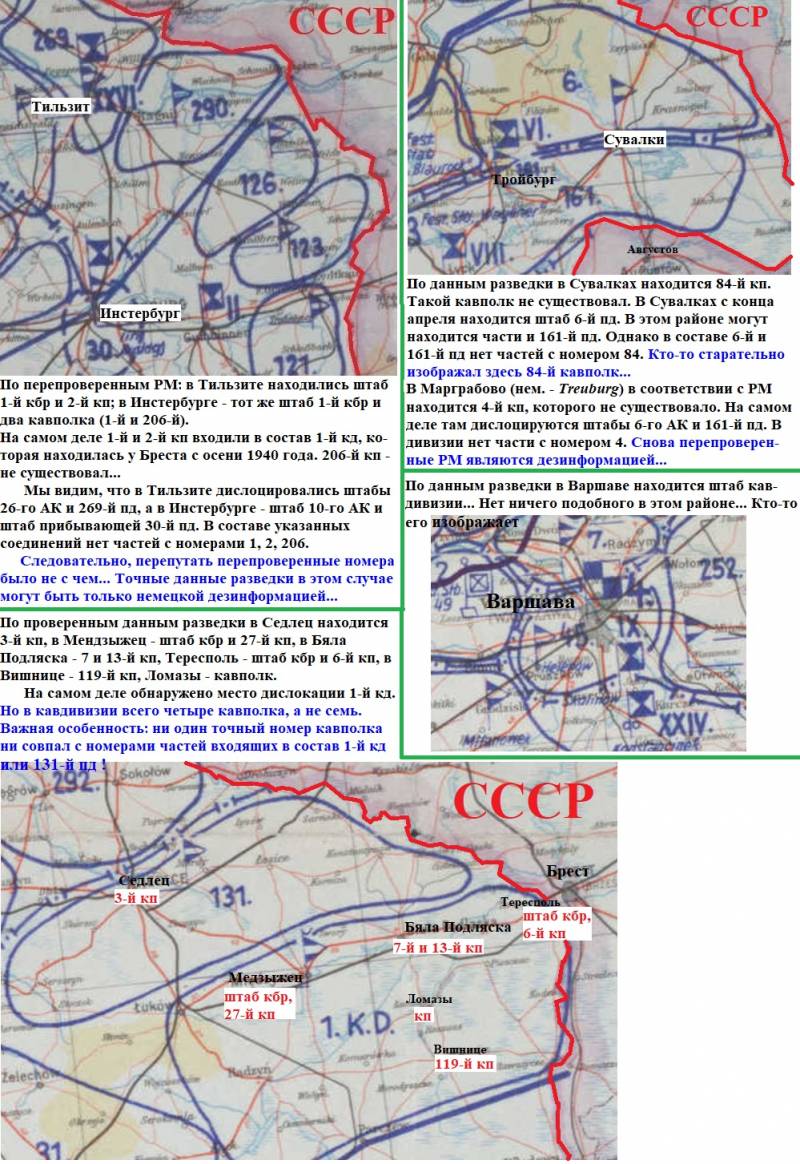
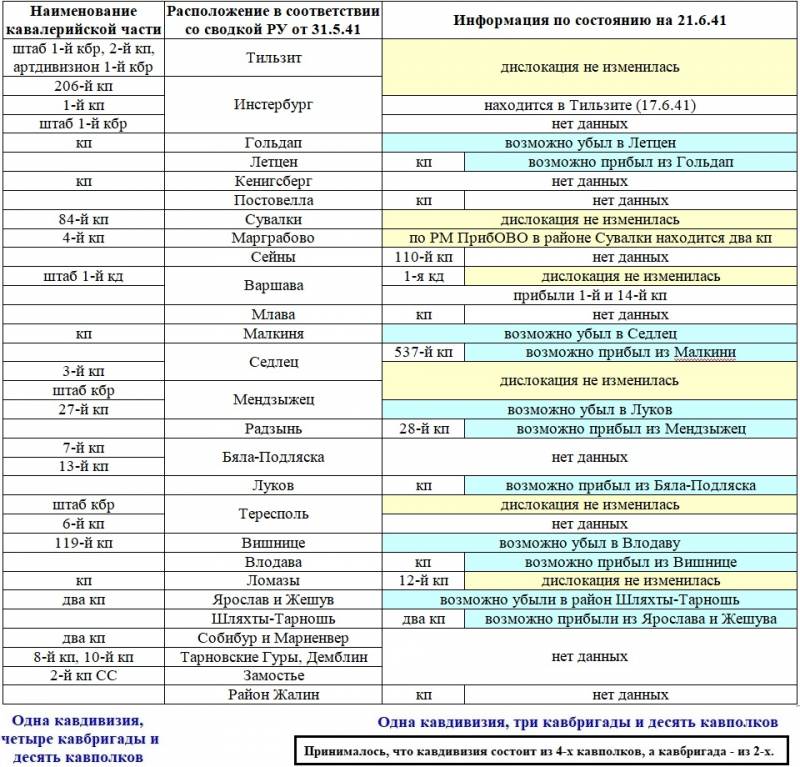
Information